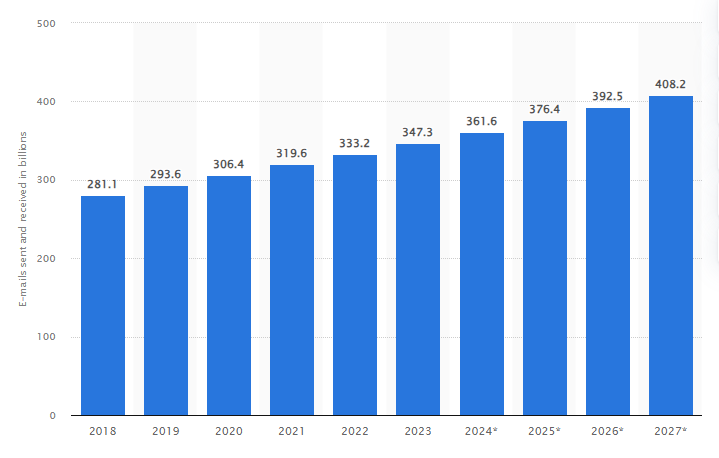Cold emailing is a powerful yet often misunderstood tool in the arsenal of lead-generation strategies. In comparison to other methods of generating leads, cold emails generate higher returns on investment.
Increasing competition has forced companies to turn to email lead generation more often than conventional marketing strategies. Cold email methods are cost-effective and offer high scalability, making it an ideal approach for businesses of all sizes.
In this article, we’ll explore effective strategies for crafting compelling cold emails, backed by statistics and best practices. Let’s begin right away!
What is Cold Emailing?
Cold emailing is the process of reaching out to potential clients or contacts via email without any prior relationship or interaction.
The goal of cold emailing is to initiate a conversation, establish rapport, and ultimately convert prospects into customers. Successful cold emails are typically well-researched, tailored to the recipient’s needs, and focused on providing value rather than a hard sell.
Cold emailing has become difficult in recent years since many marketers use this method to reach prospective customers. The market is indeed competitive, but here are some reasons why you should still use cold emailing to generate leads:
Why should you have to use Cold Emailing for Lead Generation?
Here are some reasons why should you use cold email for lead generation:
1. The Use of Email Continues to Grow
Globally, the number of emails sent and received has increased every year since 2017 due to the easy accessibility of the internet. As shown in the graph, it might reach 392.5 billion daily emails by 2026.\

As businesses and individuals increasingly rely on digital communication, email remains a vital tool for connection and information sharing. Its adaptability and effectiveness make it an essential component of modern communication strategies.
2. Lead generation machine
One of the key advantages of cold emailing is its precision; it enables you to reach a highly specific audience and offers the potential for lead generation.
By focusing on individuals who have shown interest in your product or service, you can effectively engage potential customers. This targeted approach not only helps you connect with the right people but also increases awareness of your offerings, positioning your business as a relevant solution to their needs.
How to Generate High-Quality Leads Using Cold Email?
Generating high-quality leads through cold emailing involves several key strategies:
1. Research Your Audience
Understanding your target audience is crucial. Conduct thorough research to identify their points, preferences, and industry trends. It is easier to create well-defined messages to your customers if you know more about them.
2. Craft a Compelling Subject Line
The subject line of your email will be the first thing recipients will see, so make it count! It is possible to increase open rates significantly by writing a well-crafted subject line.
3. Personalize Your Message
You should address the recipient by name and provide details about their company or industry. Use insights from your research to demonstrate that you’re not sending a generic email, but rather reaching out with a relevant solution.
4. Focus on Value
Instead of pitching your product or service immediately, highlight the value you can offer. Explain how you can solve a problem or meet a need they may have. Providing statistics and case studies to back up your claims is a good idea.
5. Include a Clear Call to Action (CTA)
End your email with a straightforward CTA. Make it clear where you want them to go next, whether it’s to schedule a phone call, to visit your website, or to respond to your email.
6. Follow Up
Don’t be dissatisfy if you don’t receive a response right away. Following up with a polite reminder can significantly boost your chances of getting a reply. Many successful conversions happen after several follow-ups.
Why Should You Verify Email Addresses Before Sending Cold Emails?
Verifying email addresses before sending cold emails is a crucial step that can significantly impact your outreach success. Here are some reasons why this practice is important:
1. Control Bounce Rates
High bounce rates occur when emails are sent to invalid or non-existent addresses. When your bounce rate is increased, it can signal to email service providers that you are a spammer, which can affect your sender’s reputation. Using bulk email verification tools helps maintain a clean email list, control email bounce rate and ensure your emails reach the right recipients.
2. Improve Deliverability
If you regularly send emails to invalid addresses, your overall deliverability rates can drop. In other words, not only will your emails go to spam folders, but they may also be blocked in the future. Verifying email addresses ensures that your messages are being sent to real inboxes and you can keep email away from spam, which improves your chances of being seen by potential leads.
3. Increase Open Rates
A clean and verified email list leads to higher open rates. When you target verified addresses, you are more likely to engage with interested prospects who are open to your outreach. Higher open rates not only reflect your efforts well but also contribute to improved performance metrics for future campaigns.
4. Save Time and Resources
Investing in email verification tools like MyEmailVerifier can help you avoid wasting time on unresponsive leads. By filtering out invalid addresses upfront, you can focus your efforts on engaging with prospects who are more likely to convert, optimising your resources for better results.
5. Build Trust
Sending emails to verified addresses enhances your professionalism and builds trust with recipients. If your emails consistently reach valid inboxes and provide relevant content, you’re more likely to foster a positive relationship with potential customers.
6. Enhance Brand Reputation
An email marketing campaign’s long-term success depends on maintaining a good sender reputation. By verifying email addresses, you help to increase the reputation of your brand among recipients and email service providers.
Final Thoughts
Cold emailing can be an effective method for generating leads when executed thoughtfully. By understanding your audience, crafting personalized messages, and verifying email addresses, you can significantly improve your chances of success. Boost your business today by generating leads!
Verify Your Cold Email List for Better Lead Generation
Clean Your List Before Sending Cold Emails
FAQs
What is cold emailing?
Cold emailing is the process of reaching out to potential clients or contacts via email without any prior relationship or interaction.
How successful is cold emailing for lead generation?
Cost emailing response rates is up to 1% to 5%, but with proper strategy and personalization it can be reach up to 20% or more.
What tools can I use for email verification?
MyEmailVerifier is a popular tool for verifying email addresses. This tool can help you to control bounce rate, clean your email list and ensure you’re reaching valid leads. Click here to find which is better for an email checker.
How many cold emails should I send in a day?
If you starting to send cold email, you can send 20 to 50 mail per days. As you approach the right audience you can increase this number while maintaining quality.
What are common mistakes to avoid in cold emailing?
Among the common cold emailing mistakes to avoid are sending impersonal, generic messages and not following up.
James P. is Digital Marketing Executive at MyEmailVerifier. He is an expert in Content Writing, Inbound marketing, and lead generation. James’s passion for learning about people led her to a career in marketing and social media, with an emphasis on his content creation.
